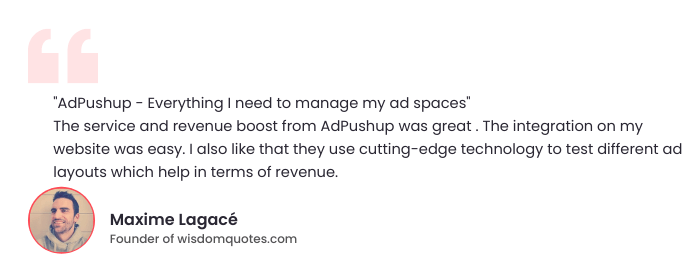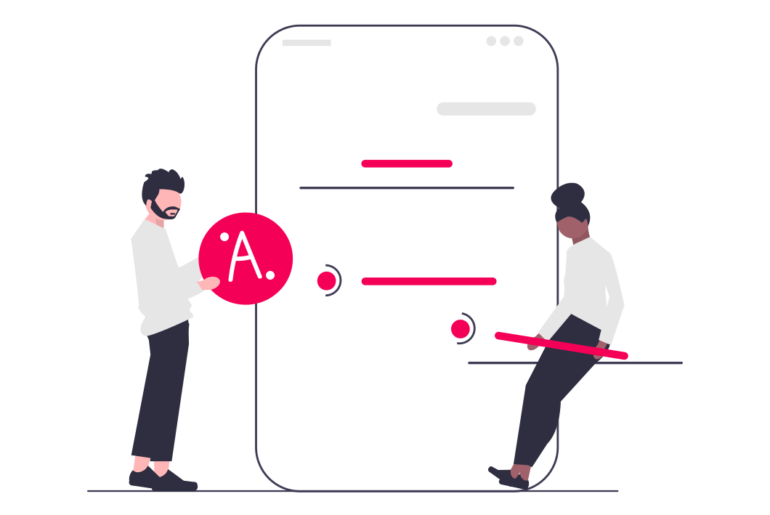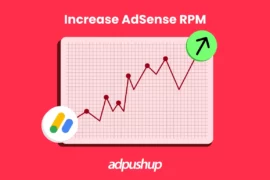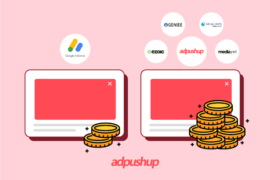Publishers often wonder how AdSense CPM rates are decided and all the factors that affect their final earnings. Here’s all the information you need.
Quora and Google AdSense help forums are littered with questions about how much you can earn with AdSense, AdSense CPM ad rates, and the like. Since AdSense CPM rates are variable, it leads to a lot of speculation among publishers. Here are a few such questions:
- How much can I earn with 1000 visitors / day with AdSense?
- What factors affect AdSense CPM?
- How much traffic will I need to earn $1000 / month with AdSense?
In this post, we’re going to look into the AdSense bid types and the factors that affect how much you can earn. That should hopefully answer most of the questions above.
Also read: Google AdSense: Guide to Improve your Existing Revenue
To begin, AdSense uses four bid types for ads:
- CPM (cost per 1000 impressions)
- Active view CPM (cost per 1000 ‘viewable’ impressions)
- CPC (cost per click)
- CPE (cost per engagement)
Publishers don’t get to choose these bid types, as they are set by advertisers during campaign creation. All these bids compete against each other; AdSense runs the competition by converting all the bids to a common metric called eCPM (estimated CPM) before the auction.
Finally, for revenue reporting purposes, AdSense uses the RPM (revenue per mile) metric, which tells the publisher how much revenue they have generated per 1000 ad impressions. Here’s how it’s calculated: RPM = Revenue generated/total ad impressions *1000
How AdSense CPM Rates are Decided (tl;dr)
Open auctions (through AdSense, AdX, and other ad networks and exchanges) use second-price auctions to determine the final payout. This means that the the highest (winning) bidder will pay one cent more than the second-highest bid.
Let’s understand this with an example. Assume there are three bidders A, B, and C, who bid $8, $2.5, and $2 respectively. Out of these, B made the second highest bid, so the winning bid will be set at $2.5 + $0.01 = $2.51. As you can see, bids that are too high or too low are ignored, bearing no effect on the winning bid. This means that the CPM rates are decided by:
- The price that advertisers are willing to pay for an impression, and more importantly;
- How many advertisers are willing to pay that price
Factors that Affect AdSense CPM Rates (long version)
It’s easy to explain away CPM rates using second-price auction dynamics, and while that is a valid explanation, it’s not the whole story—only part of the picture. How do buyers decide how much to bid? And why do some publishers generate as much as $50 CPM while others can barely touch $3? Here are some of the factors that decide how much you can earn.
Geography
English-speaking countries tend to have higher CPM rates compared to non-English speaking countries. Apart from that, the average CPM also depends on the spending power of the people in a country and how developed the online advertising industry is in those countries.

Cookie data
Advertisers bid more when they are confident that a user will convert. And the cookie trail created by a user as they browse through a website helps provide the data for better ad targeting. For instance, cookie data might show that the user has an affinity for technology.
Device types
Even though mobile internet usage has surpassed desktops in recent times, when it comes to CPM rates, desktops still earn top dollar. This is because small screen sizes and slower network speeds on mobiles and tablets lead to lower conversion rates compared to desktop.
Niche / topic
Having a well-defined niche encourages buyers to bid higher in auctions because they know the users will be more likely to convert. This is why a website that focuses on a particular topic (such as health, finance, technology) will generate greater CPM than a generic website.
Purchase intent
The stage that website users are within their buyer’s journey also affects earnings. Buyers will bid higher if they know that the user is about to make a purchase. Therefore, a website that reviews or compares products will have higher CPM rates than say, a news website.
Website quality
Some buyers place a lot of emphasis on where their ads appear. As more and more brands start taking brand safety into account, publishers who have a website with good user experience and brand safe content stand to earn more than publishers who don’t take that into account.
Ad sizes
The choice of ad formats has a significant impact on bids and publishers will do well to capitalize on that knowledge. Generally speaking, larger ad units command higher CPMs. In addition, some popular ad sizes have greater demand than others, such as 720×90 (leaderboard), 300×600 (half page), 320×100 (large mobile banner), 300×250 and 336×280 (squares).
Ad viewability
Viewability is an important metric for advertisers, especially when they know they are bidding for impressions. Google defines viewable impressions as, “when at least 50% of the ad is displayed on-screen for at least one second.” A low viewability score will make CPMs plummet.
Past performance
Most big advertisers use demand-side platforms and analytics tools to measure ad performance, this is not shooting in the dark—they know about the quality of traffic and click performance coming from the publishers they work with. When advertisers get good return on their investment, they are more likely to bid higher in future auctions.
Number of ad units
A lot of publishers think that adding more ad units is always good. That’s not accurate, even though your revenue might increase by adding units, the impression-level AdSense CPM rates will decline due to a shift in supply/demand dynamics during the auction and user attention splitting between units. Don’t assume that adding more ad units is the solution. Run an experiment instead.
Clickthrough Rate (CTR)
In case of buyers who pay for clicks instead of impressions, RPM is a function of CTR and CPC, so the payout depends on how many ads were clicked along with revenue generated per click on average, making CTR an important factor when it comes to determining AdSense revenue.
Seasonality
Most publishers are familiar with the January CPM slump, which is a drop in CPM rates because advertisers are busy planning ad campaigns for the coming quarter and year—this is just one example of seasonality at work. Seasonality varies by country, event (Black Friday, Cyber Monday, etc), and time of the year (travel sites earn more towards the end of the year).
Key Take Aways
- AdSense uses four bid types for ads: CPM, Active view CPM, CPC, and CPE. Publishers don’t get to choose these bid types, but AdSense runs an auction.
- Publishers should know that larger ad units command higher CPMs, and that some ad sizes are in greater demand than others.
- A lot of publishers think that adding more ad units will increase revenue, but it won’t. Run an experiment instead.
- The January CPM slump is a drop in CPM rates because advertisers are busy planning ad campaigns for the coming quarter and year.
Frequently Asked Questions
In AdSense, you are paid per click or per impression. Revenue per click is calculated by multiplying click-through rate by cost per click. Revenue per impression is calculated by cost per mile (CPM).
Adsense pays you for either clicks or views, which are also known as impressions. AdSense pays you on the basis of your Cost per Mille, also known as CPM. You’ll get paid per thousand impressions depending on your CPM.
Your CPM is affected by eight factors-
i. Demand and supply.
ii. Changing seasons.
iii. Platform choice.
iv. Size of the audience.
v. The campaign’s target.
vi. Geography.
vii. Ad format and creative efforts.

Deepak has a keen eye for detail and a deep understanding of the ad tech landscape. Whether it’s through in-depth articles, thought-provoking insights, or compelling storytelling, he’s dedicated to helping people navigate the complex world of ad tech with the simplicity of his words.



![18 Actionable Tips to Increase Adsense Revenue + [Bonus Tips for Video Ads] Google adsense revenue](https://www.adpushup.com/blog/wp-content/uploads/2023/06/featured-image_01-1-270x180.png)




2 Comments
hello sir, I would know how much you can earn with adsense for 3000 pages views in the worst cases? thank you
I am not justified for my Adsense page RPM is good or bad
my AdSense page rpm is varying from $ 0.40 to $0.60.
my site niche is education and 99% traffic from India.
thanks